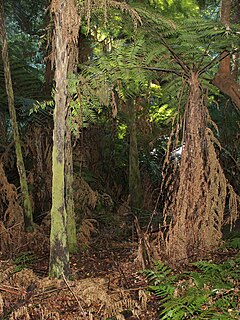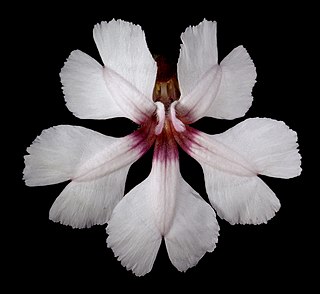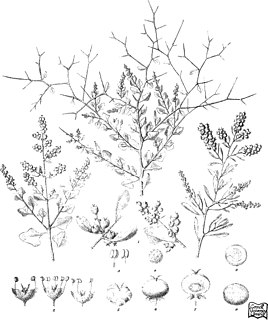
The National Herbarium of Victoria is one of Australia's earliest herbaria and the oldest scientific institution in Victoria. With 1.5 million specimens, it houses the largest collection of pressed, dried plant specimens in Australia, including scientifically and historically significant collections gathered by Joseph Banks and Daniel Solander during the voyage of HMS Endeavour in 1770, 2,000 specimens collected by Robert Brown during Flinders' circumnavigation of Australia (1801–1805), and three collections made by Darwin during the Voyage of the Beagle to South America, Australia, and the Pacific. The herbarium was established in 1853 by Ferdinand von Mueller, the Government Botanist for Victoria, and is situated within the Royal Botanic Gardens, Melbourne. The present building was constructed in 1934 through a donation from philanthropist Sir Macpherson Robertson. It, along with a 1989 extension, houses the entire collection of 1.5 million plant and fungal specimens. The Herbarium's botanic library is an important source for the history of Australian botany, and has contributed some 124 volumes to the online digital Biodiversity Heritage Library.

Cyathea leichhardtiana, the Prickly Tree Fern is a plant in the tree fern family, Cyatheaceae, found in eastern Australia. A common species found in moist situations, in and near rainforests. Named in honour of the explorer and botanical collector Ludwig Leichhardt.
Hollandaea sayeriana, sometimes named Sayer's silky oak, is a small species of Australian rainforest trees in the plant family Proteaceae.

Joachim Steetz was a German botanist. His herbarium, comprising more than 5000 specimens from over 160 collectors and 50 countries was purchased in 1863 by Victorian Government Botanist Ferdinand von Mueller for the sum of 80 pounds.
Charles Hugh Fawcett was an Irish-born Australian politician.

Haemodorum brevicaule is a perennial herb from 0.025 to 0.3 m tall, in the bloodroot family, the Haemodoraceae, native to northern Australia. It has deep-red to purplish-black flowers which are seen from September to December, and it grows on red clay and basalt.

Nymphoides crenata, commonly known as wavy marshwort, is an aquatic perennial herb of the family Menyanthaceae endemic to Australia, found in all mainland states and the Northern Territory

Velleia paradoxa, or spur velleia, is a small, softly pubescent perennial herb in the family Goodeniaceae, endemic to Australia. It is found in South Australia, Tasmania, Victoria, New South Wales and southern Queensland. It grows in sclerophyll forest and grassland. It has oval to elliptical leaves which are from 7–25 centimetres (3–10 in) long and it flowers mainly from August to February.

Velleia lyrata is a small perennial herb in the family Goodeniaceae, endemic to Australia. It is found mainly near Sydney, but also near the NSW and Queensland border, and in Queensland. A map of its occurrence records is given here. It grows in damp situations in heath on sandy soils. The cordate base to the adaxial sepal is a feature distinguishing it from many other Velleias. A full description of the plant is given in Flora of Australia online.

Maireana pyramidata is a species of plant within the genus, Maireana, in the family Amaranthaceae. It is endemic to Australia, and widespread throughout Australia in the inland, where it is found in Victoria, New South Wales, Queensland, the Northern Territory and Western Australia.

Velleia rosea is a member of the family Goodeniaceae that is native to Western Australia and flowers from April to October.

Chenopodium spinescens is a species of plant in the family Amaranthaceae, endemic to Australia. It is found in all states and territories of Australia with the exception of Tasmania.

Velleia macrophylla, or large-leaved Velleia, is a perennial herb in the family Goodeniaceae, which is endemic to Western Australia. It grows on moist sites in Beard's South-west province. It flowers from October to December or January.

Velleia glabrata is an annual herb in the family Goodeniaceae, which is native to all mainland states and territories of Australia with the exception of Victoria. It grows on sand and clay, flowering from June to October.

Bossiaea bossiaeoides is a glaucous shrub from 0.5 to 2 m high, in the pea family (Fabaceae), which is found in northern Australia, in the Northern Territory, Queensland and Western Australia. Apparently leafless, it has branches which are broadly winged. It grows on sand and sandstone, on stony hillsides, creek banks and outcrops. Its flowers are yellow and it flowers from April to August.

Bossiaea rupicola is an erect shrub in the pea family (Fabaceae), which is native to Queensland and New South Wales.

Bossiaea stephensonii is a perennial multistemmed shrub in the pea family (Fabaceae), and is native to New South Wales.

Council of Heads of Australasian Herbaria (CHAH) is an association of the leaders of herbaria in Australia and New Zealand. It is governed by a constitution. It endorses the taxonomy and nomenclature of the Australian Plant Census, which is the source for accepted names of species and, in particular, for accepted names of Australasian species. It supports the Australian Plant Name Index. CHAH is incorporated in the A.C.T. and is an Australian registered business with ABN 31 496 409 479.
Anna Frances Walker (1830–1913) was an early Australian botanical collector and plant illustrator.

Ptilotus divaricatus is a grass-like plant in the Amaranthaceae family.

















